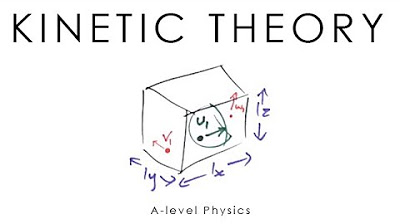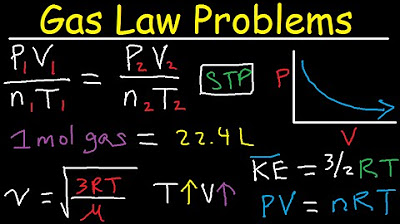Ideal gas equation: PV = nRT | Chemistry | Khan Academy
TLDRThis script explores the concept of pressure in a gas-filled balloon, explaining it as force per unit area exerted by gas particles bouncing off the balloon's interior. It introduces temperature as the average kinetic energy per particle, affecting the pressure. The video builds up to the ideal gas equation, PV = nRT, by considering factors like temperature, number of particles, and volume. It also clarifies the assumptions behind the ideal gas model, such as no intermolecular attraction or repulsion and negligible molecular volume.
Takeaways
- 🎈 The pressure exerted on the surface of a balloon is a result of gas particles bouncing off the walls of the container.
- 🔢 Pressure is defined as force per unit area, with the area being the inside surface of the balloon.
- 🏃 The faster the gas particles move, the higher the pressure, as they collide more frequently and with greater force against the balloon's wall.
- 🤯 It is impractical to measure the kinetic energy of each individual particle, so we consider the average energy of the particles.
- 🌡 Temperature is viewed as the average kinetic energy per particle in a system, indicating how fast the particles move on average.
- 🔄 The total energy in the system is the product of temperature and the number of particles, often represented in terms of moles.
- 📉 The pressure in a container is inversely proportional to its volume; decreasing the volume increases the pressure due to more frequent collisions in a smaller space.
- 📚 The ideal gas equation, PV = nRT, relates pressure (P), volume (V), the number of particles (n), a constant (R), and temperature (T) for an ideal gas.
- 🌌 An ideal gas is assumed to have particles that do not attract or repel each other and have negligible volume, allowing for the application of the ideal gas equation.
- 🔬 The ideal gas equation is based on certain assumptions and provides a useful model for understanding the behavior of gases under various conditions.
- 🧠 Understanding the intuition behind the ideal gas equation is crucial for grasping its application in solving chemistry and physics problems.
Q & A
What is the relationship between the kinetic energy of gas particles and the pressure exerted on the walls of a container?
-The kinetic energy of gas particles is directly related to the pressure exerted on the container walls. Faster moving particles will collide with the walls more frequently and with greater force, resulting in higher pressure.
Why is it impractical to measure the kinetic energy or velocity of each individual particle in a gas?
-It is impractical because in a real gas, there are an extremely large number of particles, often in the order of 'gazillions', making it impossible to measure each one individually.
What concept is introduced to represent the average energy of particles in a system?
-The concept of temperature is introduced as a representation of the average kinetic energy of the particles in a system.
How does the number of particles in a container affect the pressure exerted on its walls?
-The more particles there are in a container, the more frequent and forceful the collisions with the container walls, leading to an increase in pressure.
What is the significance of the term 'moles' in the context of the ideal gas equation?
-Moles represent the number of particles in a substance, and in the context of the ideal gas equation, it is used to quantify the total number of particles when calculating pressure.
What is the ideal gas equation, and what does it represent?
-The ideal gas equation is PV = nRT, where P is pressure, V is volume, n is the number of moles of gas particles, R is the ideal gas constant, and T is temperature in Kelvin. It represents the relationship between these variables for an ideal gas.
What assumptions are made about the behavior of gas particles in the ideal gas equation?
-The ideal gas equation assumes that gas particles do not attract or repel each other and that the volume of individual particles is negligible compared to the volume of the container.
How does the volume of the container affect the pressure of the gas inside?
-The pressure of the gas is inversely proportional to the volume of the container. If the volume decreases, the particles collide with the walls more frequently, resulting in higher pressure.
What is the role of the ideal gas constant (R) in the ideal gas equation?
-The ideal gas constant (R) is a proportionality constant that ensures the units of pressure, volume, and temperature are correctly balanced in the equation.
Why is the ideal gas equation called 'ideal'?
-The term 'ideal' refers to the theoretical nature of the equation, which assumes perfect behavior of gas particles with no intermolecular forces and negligible particle volume.
How does the temperature of a gas affect its pressure according to the ideal gas equation?
-According to the ideal gas equation, the pressure of a gas is directly proportional to its temperature. An increase in temperature leads to an increase in pressure, assuming the volume and the number of moles remain constant.
Outlines
🎈 Understanding Balloon Pressure and Particle Kinetics
This paragraph explains the concept of pressure exerted by gas particles inside a balloon. It describes how the velocity of particles, which is related to their kinetic energy, affects the pressure on the balloon's surface. The pressure is defined as force per unit area, and the force comes from particles bouncing off the balloon's interior. The paragraph introduces the idea that the average kinetic energy of particles, which is temperature, is a key factor in determining pressure. It also touches on the impracticality of measuring individual particle properties and the necessity of considering the average energy per particle. The relationship between temperature, particle count, and pressure is discussed, leading to the notion that pressure is proportional to the product of temperature and the number of particles, which can be expressed in terms of moles.
🔍 The Ideal Gas Law and Its Derivation
This paragraph delves into the relationship between pressure, volume, and temperature, which is encapsulated in the ideal gas equation. It starts by establishing that pressure is not only dependent on temperature and the number of particles but also inversely proportional to the volume of the container. The smaller the volume, the more frequently particles collide with the walls, resulting in higher pressure. The paragraph introduces the ideal gas equation, PV = nRT, where P is pressure, V is volume, n is the number of moles (a measure of the number of particles), R is the ideal gas constant, and T is temperature in Kelvin. It explains the assumptions behind the ideal gas model, such as the lack of intermolecular attraction or repulsion and the negligible volume of individual gas particles. The paragraph concludes by emphasizing the importance of understanding the intuition behind the ideal gas equation for problem-solving in chemistry.
Mindmap
Keywords
💡Balloon
💡Particles
💡Kinetic Energy
💡Pressure
💡Temperature
💡Average Energy
💡Moles
💡Ideal Gas
💡Volume
💡Ideal Gas Equation
Highlights
The pressure exerted on the surface of a balloon is a result of gas particles bouncing off its walls.
Pressure is defined as force per unit area, with the inside surface of the balloon being the area of interest.
Gas particles' kinetic energy and velocity are key factors influencing the pressure within the balloon.
The faster the particles move, the higher the pressure due to more frequent and forceful collisions with the balloon's surface.
It is impractical to measure the kinetic energy of each particle, so the average energy is considered instead.
Temperature is introduced as a measure of the average kinetic energy of particles in a system.
Higher temperature correlates with faster moving particles and increased pressure within a container.
The concept of temperature as kinetic energy per particle is crucial for understanding pressure dynamics.
The total energy in a system can be calculated by multiplying the temperature by the number of particles.
The number of particles is often represented in moles, a unit that quantifies the amount of substance.
Pressure is proportional to the product of temperature, number of particles (in moles), and a constant R.
The volume of the container plays a significant role in pressure; a smaller volume results in higher pressure.
Pressure is inversely proportional to volume, which is a fundamental concept in understanding gas behavior.
The ideal gas equation, PV = nRT, is derived from the relationship between pressure, volume, temperature, and the number of particles.
An ideal gas is characterized by particles that do not attract or repel each other and have inconsequential volume.
The ideal gas equation assumes an ideal scenario where intermolecular forces and particle volume are negligible.
The ideal gas equation provides a foundational understanding for solving gas-related problems in chemistry.
The video promises to delve into the practical applications and mathematical manipulations of the ideal gas equation in subsequent content.
Transcripts
Browse More Related Video

Kinetic Molecular Theory of Gases - Practice Problems

Kinetic Theory of Gases - A-level Physics

Proof: U = (3/2)PV or U = (3/2)nRT | Thermodynamics | Physics | Khan Academy

Gas Law Problems Combined & Ideal - Density, Molar Mass, Mole Fraction, Partial Pressure, Effusion

Kinetic Molecular Theory

Ideal gas equation example 2 | Chemistry | Khan Academy
5.0 / 5 (0 votes)
Thanks for rating: